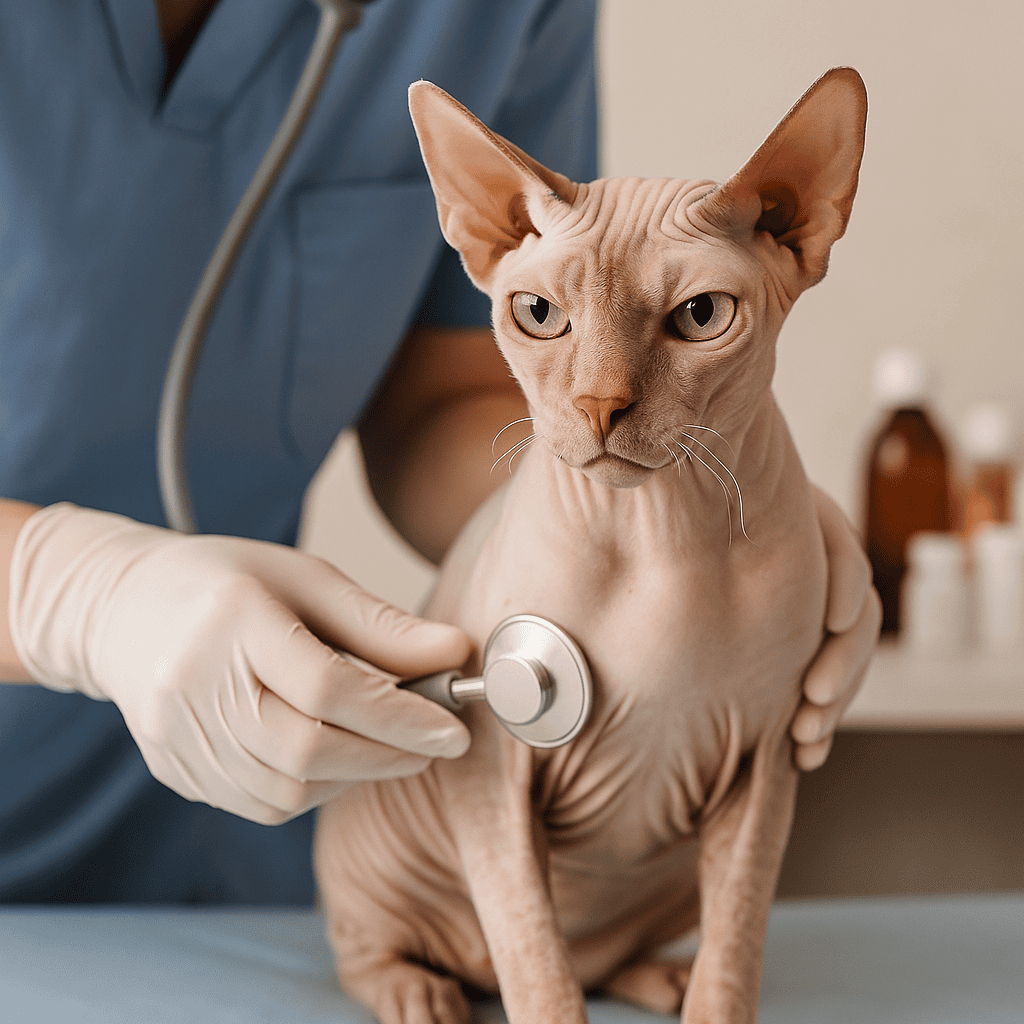When you think of the Sphynx cat, you likely imagine its unique, hairless appearance and wrinkly skin. But owning a Sphynx is about more than their looks—it’s about being prepared for the specific needs and Sphynx Cat Health Issues are prone to. If you’re a current or prospective owner, understanding these health challenges can make all the difference in helping your feline companion live a long, happy life.

Why Sphynx Cats Are Prone to Health Issues
Sphynx cats may look tough with their muscular frames and striking appearance, but they are genetically predisposed to several health concerns. Their lack of fur, for instance, makes them more vulnerable to temperature changes and skin irritations. And since they’re a selectively bred breed, some genetic conditions are more common among them.
Common Sphynx Cat Health Problems
Hypertrophic Cardiomyopathy (HCM)
HCM is the most common heart condition in Sphynx cats. It causes the heart walls to thicken, reducing the organ’s efficiency. Sadly, it can be hard to detect until symptoms appear.
Symptoms to watch for:
- Labored breathing
- Lethargy or sudden collapse
- Decreased appetite
What to do:
Regular echocardiograms are essential, especially if your cat comes from a breeder. Ask whether the parents were tested for HCM.
According to the Cornell Feline Health Center, early detection of heart issues in cats, especially in breeds like the Sphynx, can improve life expectancy.
Skin Conditions and Infections
Without fur to absorb oil, Sphynx cats develop oily skin buildup quickly. This can lead to acne, rashes, and yeast infections.
Common issues include:
- Greasy or flaky skin
- Acne on the chin
- Fungal infections in skin folds
Care tip:
Wipe them down with a gentle, hypoallergenic cloth a few times a week. A weekly bath with a cat-safe shampoo helps prevent build-up and odor.
Respiratory Problems
Because of their short muzzles and exposed skin, Sphynx cats are more susceptible to respiratory infections—especially when exposed to drafts or rapid weather changes.
Signs include:
- Sneezing
- Nasal discharge
- Coughing or wheezing
Keeping them warm and dry, especially after bathing, is critical to preventing illness.
Dental Issues
Dental disease is common in many breeds, but Sphynx cats are especially prone to periodontal problems. Inflammation, plaque, and tooth decay can sneak up quickly.
Tips for prevention:
- Brush their teeth with a vet-approved toothpaste
- Offer dental treats or prescription dental diets
- Schedule regular professional cleanings
Refer to our complete guide: How to Brush a Cat’s Teeth Without Stressing Your Pet
Ear Infections
Sphynx cats have no fur to catch debris, and they produce more earwax than most breeds. This creates the perfect environment for bacteria.
Watch for:
- Head shaking
- Redness or swelling in the ear canal
- Unpleasant odor
Cleaning tip:
Use a vet-approved ear cleaner once a week. Avoid cotton swabs and instead use a soft cloth or gauze.
How to Keep Your Sphynx Healthy
Here’s how to reduce risks and improve your Sphynx’s well-being:
- Routine vet checkups: Aim for annual or bi-annual visits
- Temperature control: Keep your home between 68°F–75°F
- Balanced nutrition: Choose high-protein, grain-free food for skin and heart health
- Sun protection: Never let them sunbathe without protection—they can burn
- Avoid exposure to drafts and dampness
Explore fluffze.com for more tips on nutrition and grooming that are tailored to indoor and high-maintenance pets like the Sphynx.
What to Ask Your Vet
When adopting or caring for a Sphynx cat, make sure to ask:
- Has the cat been screened for HCM?
- What skin care routine do you recommend?
- How often should dental cleanings be scheduled?
- What should I look out for in terms of behavior changes?
Regular vet guidance ensures you’re catching problems before they become serious.
Real Owner Insight
Most pet owners don’t realize how much work goes into caring for a hairless cat until they experience it firsthand. A reader from our Fluffze community, Jessica, shared:
“My Sphynx, Oliver, had recurring skin breakouts. I learned to switch to a fragrance-free baby wipe and clean his wrinkles daily. It sounds like a lot, but it’s just part of the routine now—and he’s so much happier.”
It’s small adjustments like these that can make a huge difference.
FAQs
Are Sphynx cats high maintenance?
Yes. From weekly baths to frequent ear and dental cleanings, they require more hands-on care than the average breed.
Can Sphynx cats get sunburned?
Absolutely. Their hairless skin is sensitive and can burn quickly under direct sunlight. Use a vet-recommended sunscreen if needed.
How often should I bathe my Sphynx?
Most need a bath every 7–10 days to prevent oil buildup and skin irritation.
Is it true they get cold easily?
Yes. Because they don’t have a fur coat, they need warm bedding, sweaters, or heated pads in cooler months.
Do Sphynx cats have more allergies?
They can develop skin allergies or food sensitivities, so always monitor for signs like itchiness or redness.
Final Thoughts
Sphynx cats are undeniably special—but with their beauty comes responsibility. By understanding Sphynx cat health issues, you can take proactive steps that promote a healthy, comfortable life. It all starts with knowledge, consistency, and love.
Call-to-Action
If you found this guide helpful, share it with fellow Sphynx cat owners. For more real-life care advice, check out our full section on Cat Health & Wellness.
Written by Author Box
Written by Shawn, pet lover & contributor at Fluffze
Related Articles:
Sphynx Cat Care: A Complete Guide to Raising a Hairless Cat
Homemade Dog Food for Itchy Skin
Smart Cat Dental Care at Home: Keep Your Cat’s Smile Healthy





